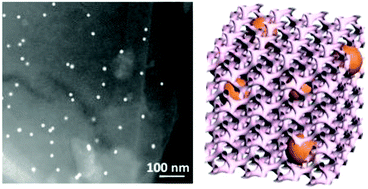Nanoengineering of aggregation-free and thermally-stable gold nanoparticles in mesoporous frameworks†
Abstract
Loading catalytically active, aggregation-free and thermally stable metal nanoparticles (NPs) on a high surface area support represents a major interest in heterogeneous catalysis. Current synthetic approaches to these hybrid catalysts, however, still lack controllability in the thermal stability of metal NPs, particularly at high temperatures in the absence of organic ligands. We herein report a facile “co-assembly” methodology to prepare aggregation-free, ligand-free and thermally stable mesoporous hybrid nanocatalysts of metal–oxides and metal–carbons. Immobilization of catalytically active gold NPs (AuNPs) within high surface area mesoporous frameworks was achieved via the polymer-directed co-assembly of chemically and structurally equivalent Pluronic P-123 and poly(ethylene oxide)-modified metallic gold NPs (AuNP-PEO) as co-structure-directing-agents. The in situ immobilization of AuNPs partially embedded into periodically ordered mesoporous frameworks imposed a three-dimensional “nanoconfinement” effect and essentially enhanced the long-term thermal stability of AuNPs up to 800 °C. The mesoporous hybrids retained a high surface accessibility of AuNPs and they had a fantastic high-temperature catalytic durability (>130 h at 375 °C) confirmed by two model catalytic reactions, including aerobic oxidation of benzyl alcohol and CO oxidation, respectively. Our results may offer a new realm of possibilities for the rational applications of thermally stable nanocatalysts in renewable energy technology and high-temperature catalysis.



 Please wait while we load your content...
Please wait while we load your content...